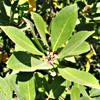Laurel (Sweet Bay) is an evergreen tree, which grows in a humid Mediterranean Maqui. The tree is usually short, but may reach a height of 8 meters or more. It is often grown in ornamental gardens, and is well known mainly due to the special scent emitted by its leaves. The tree needs humidity but is sensitive to frost. Its leaves are simple, leathery, elliptical, with an entire margin and usually undulate. They are bright green and emit a sharp odor when rubbed – an odor that reminds you of pickled fish and other foods that are seasoned with bay leaves. The leaf arrangement on the stem is alternate.
Laurus nobilis blooms in the spring, between March and May. The tree is dioecious, the flowers are fragrant, gathered in inflorescences that develop in leaf axils or at the tips of branches. The flowers are yellow-white, with 4 tepals. The female inflorescence has few flowers. The ovary is superior with one loculus. The male inflorescence has numerous flowers, numerous stamens which are attached to the corolla.
The fruit is an ovate drupe that resembles an olive. It is up to 17 mm in length, green and turns black upon ripening. The fruits contain oil which is extracted from them. The plant is reproduced by seeds and by cuttings. True laurel grows in Israel on Mount Carmel, in the Western Galilee, the Peki’in mount, the Upper Galilee, Mount Hermon as well as in Samaria and the Judean Hills. Its global distribution encompasses the countries surrounding the Mediterranean Sea.
In folk medicine, the oil extracted from the fruits and leaves is used for various purposes: for calming rheumatic pain and earaches. The oil is used for anointing the body and as cosmetic oil, and as an additive of fragrance in the soap industry. It is also used for treatment of diarrhea, stomach poisoning and colds.
The leaves are also known as “bay leaves” and are used as flavoring for meat and fish dishes and for curing olives and vegetables. The leaves are used for wrapping figs in the process of turning them into dried figs, and for preserving the freshness of tobacco.
Written by Erga Aloni






